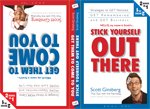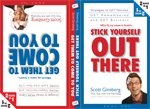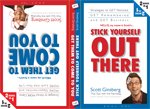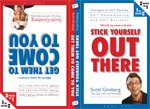 “Your combination is: One, two, three, four, five? That’s the stupidest combination I’ve ever heard in my life! That’s the kind of thing an idiot would have on his luggage!”
“Your combination is: One, two, three, four, five? That’s the stupidest combination I’ve ever heard in my life! That’s the kind of thing an idiot would have on his luggage!”
Name that movie.
Spaceballs, of course.
My brother and I grew up on this film. And to this day, we can still recite the entire script, line by line.
If you’re not familiar with the movie, here’s a quick synopsis:
Spaceballs is a 1987 science fiction spoof in which Planet Spaceball, led by President Skroob (Mel Brooks) has wasted all of its air, leaving the inhabitants to survive off canned oxygen called Perri-air. Ingeniously, Skroob sends Lord Helmet (Rick Moranis) to steal Planet Druidia’s abundant supply of air to replenish their own, and only Lone Starr (Bill Pullman) can stop them.
Now, even though the movie is a spoof, there’s still a powerful life lesson to be learned from Spaceballs:
When you’re known as a breath of fresh air, the people who matter will come in droves to inhale.
Customers.
Coworkers.
Employees.
Supervisors.
Board members.
Whoever comprises your constituency, nothing serves them better than making yourself a breath of fresh air.
Here’s how:1. Embrace your outsiderness. Being an outsider gives you an inside track. For three reasons.
First, outsiders can be truly objective. They have little or no bias. They can recognize patterns immediately. They have no stake in the company or organization. They don’t bring vested interests to an existing problem. They can explore the structure of an organization with fresh eyes. And they’re not viewed as a threat, which diffuses defensiveness and increases willingness to listen.
Secondly, outsiders don’t face traditional barriers. They’re unaware of common creative blocks. They’re not subject internal politics of the organization. And they’re able to explore assumptions the organization that were never considered or taken for granted.
Finally, outsiders can deliver independent thought. Their thinking patterns are different. They’re detached from the outcomes. They’re not so close to the situation and therefore have limited agendas. And their wealth of diverse background experience applies cross-industrially.
Ultimately, people are tired of listening to the same messages from the same people. Embrace your outsiderness today and move into a position of value tomorrow.
Remember: It’s a lot easier to break the limit when you don’t know the limit exists. And sometimes it takes a person who knows nothing to change everything. Are you willing to admit that you’re not part of the club?
2. Embody the extinct. Just out of curiosity, I recently googled the phrase, “What’s lacking is a sense of…” Across all industries, the most common item that came up was “urgency” or “immediacy.”
Interesting. Perhaps the acceleration of technology combined with our hyperspeed culture is the wakeup call companies need to increase their average response time. Just one example.
Either way, if you want to become a breath of fresh air, become a living example of what’s lacking in the rest of the world. Conduct research on your own – either online or person – to find out what’s extinct in your world. Then position yourself as the opposite.
For example, few professional speakers post their fees publicly on their website. And that’s exactly why I post mine: To embody the transparency that’s sorely lacking in my industry. The best part is: My clients love it. What obsolete value are you making obligatory?
3. Dumbing down is stepping up. A few books into my career as a writer, my editor informed me that most of material was written at a fifth or sixth grade level.
And I asked her, “Is that good?”
To which she replied, “Absolutely! Twelve years old the level most adults read at.”
Now, admittedly, this attribute of my writing isn’t so much a strategy as it is representative that I never really matured past twelve years old. But I’ll take it.
Either way, it works for my readers. And that’s what matters.
Lesson learned: Stop cluttering your interface. Whether that’s in person, online or on the phone, remove whatever surrounding complexity you can from the way people experience you and your message.
Slow things down from the usual hectic pace. Let your audience breathe. As a writer (and don’t act like you’re not a writer – everyone’s a writer), your best tool for accomplishing this is with the Flesch-Kincaid Tests.
They’re easily found on most word processing grammar checks. And they’re designed to measure comprehension difficulty and readability when reading a passage of contemporary academic English.
Remember: What’s the point of being fresh air if you don’t give people adequate pauses to inhale? It’s time to step it up by dumbing down. What metrics will you use to simplify your message?
4. Perspective is priceless. My friend Marcus writes books and gives lectures to healthcare professionals. But, not because he’s an expert on patient care. Or a doctor. Or a medical researcher.
Rather, because after a tragic auto accident, Marcus spent two years of his life restricted to a hospital bed, a feeding tube and respirator. You can’t teach perspective like that.
And that’s why, when Marcus delivers his message – from the page or the stage – the same breath of fresh air that re-inflated his once failing lungs now fills the hearts of the people in his audience. No wonder he gets invited back every year.
Lesson learned: The keener your perspective, the fresher your breath. Your challenge is twofold: First, to wreck your car. Just kidding. Marcus made me put that joke in.
Seriously: Figure out which of your unique experiences have afforded you with the deepest amount of perspective. Then, creatively deliver your message from that perspective. How will your worldview add a new dimension to the overall picture?
5. Create an original and unique experience. Don’t tell me there’s nothing new under the sun – it’s 864,938 miles in diameter. If you can’t say something new, you’re not trying very hard.
All you have to do is tell the truth – your truth. Not Benjamin Franklin’s truth. Not Rumi’s truth. Your truth. Stop being a vending machine of other people’s quotations. Instead, start spouting the wisdom of your life. It’s there, waiting to be excavated.
The cool part is, honesty is so rare that it’s become remarkable. And when you dip your pen in your own blood, it’s always new – because it’s your original and unique experience.
Focus on crafting your messages with clients and coworkers from that space. You’ll expel more fresh air than the Sears home appliance department. Are you the origin or the echo?
6. Don’t just break the mold – shatter it. Make the mainstream to pee in their pleated pants and tremble in their penny loafers. How? By violating people’s schemas.
According to the bestselling book, Made to Stick, a schema is a collection of generic properties about an idea or category. Your challenge is to upset those patterns. To make your messages, conversations and ideas a radical departure from traditional labels.
George Carlin was a master at this. Not only did his comedy entertain us – it challenged and provoked us to rethink and unlearn. So much so, that in 1972, his monologue “Seven Words You Can Never Say on Television” led to a Supreme Court decision that helped established the extent to which the FCC would regular speech on broadcast television.
Nearly forty years later, Carlin’s regulation still carries weight today.
Lesson learned: Sweep away the stifling odor of the multitude. Refuse to fall into the same clichés as – or satisfy the unquestioned conventions of – the mediocre masses. What boundaries are you bending?
7. Sell less – solve more. That’s the biggest mistake made by businesses that use social media: They’re so busy trying to make money that they disregarded their duty to solve problems.
I’m not saying making money is wrong. But if direct monetization is your primary modality, people will smell it quickly and walk away.
Instead, I challenge you to position yourself as The Answer. To use social media as a listening platform to gain insight into what drives your customers up the wall. My friend Chris is a master of this.
“Every person who comments on my blog gets a phone call from me. And the best part is, nobody expects it. And that’s exactly what makes it a breath of fresh air. Because I’m offering myself as a resource – instead of hurling myself as a salesperson.”
What pervasive, expensive, real and urgent problem does your business solve – better, faster, smarter and cheaper than the other guys?
8. Differentiate through your emphasis. During a recent trip to Australia, I had the pleasure of flying on Virgin Airlines. Let me paint a picture for you:
Dance music blasting from the check-in area. Approachable service islands with brightly colored displays. Employees who were young, energetic and attractive – who, by the way, actually walked out from behind their desks to shake your hand, introduce themselves and welcome you to Virgin.
Then, once we boarded the plane, the experience continued. More music. More fun. And more employees who were laughing, joking and overall, (actually) enjoying their jobs. Hell, even the safety demonstration video was kind of cute.
Talk about a breath of fresh air. I said to the flight attendant, “Wow. Airline companies back in the states could learn a lot from your team – you guys look like you’re legitimately having a good time!”
And like clockwork, she replied, “At Virgin, it’s kind of hard not to.”
Not surprisingly, Virgin won several airline industry awards in 2009: Best Premium Economy in the World, Best Transatlantic Airline, Best International Airline, Best International Airline for Inflight Entertainment and Best Frequent Flyer Program.
Lesson learned: Provide an outlet to unconventional approaches. Not only will you become a breath of fresh air, you’ll become the best in the air. What do you emphasize that your competitors overlook?
REMEMBER: If you want to make a name for yourself, be conscious about what you’re breathing into people.
The choice is yours: You can lump yourself into the mediocre masses as (yet another) company that blows smoke up people’s asses.
Or, you can position yourself as a breath of fresh air, so the people who matter will come in droves to inhale.
Maybe Spaceballs was onto something.
LET ME ASK YA THIS…
Are you that refreshing?
LET ME SUGGEST THIS…
For the list called, “45 Recession-Friendly Strategies for Entrepreneurial Evolution,” send an email to me, and you win the list for free!
* * * *
Scott Ginsberg
That Guy with the Nametag
Author, Speaker, Entrepreneur, Mentor
[email protected]
 The world’s FIRST two-in-one, flip-flop book!
The world’s FIRST two-in-one, flip-flop book!
Buy Scott’s comprehensive marketing guidebook on Amazon.com and learn how to GET noticed, GET remembered and GET business!

 The word “prolific” comes from the Latin prolificus, which means, “to make offspring.”
The word “prolific” comes from the Latin prolificus, which means, “to make offspring.”  The world’s FIRST two-in-one, flip-flop book!
The world’s FIRST two-in-one, flip-flop book! “He’ll eat almost anything, idea wise, or he’ll at least chew on it. What he swallows is another matter. That’s partly because the psychedelic springs from a common-sense filled, well-informed, experience-tempered and morally solid soul.”
“He’ll eat almost anything, idea wise, or he’ll at least chew on it. What he swallows is another matter. That’s partly because the psychedelic springs from a common-sense filled, well-informed, experience-tempered and morally solid soul.” The world’s FIRST two-in-one, flip-flop book!
The world’s FIRST two-in-one, flip-flop book! “Nobody’s reading your blog because of your art. They’re reading your blog because the person you are inspires them. They’re not reading your blog because they’re thinking of buying your paintings, they’re reading your blog because the way you approach your work inspires them. It sets an example for them. It stands for something that resonates with them. It leads them to somewhere that they also want to go.”
“Nobody’s reading your blog because of your art. They’re reading your blog because the person you are inspires them. They’re not reading your blog because they’re thinking of buying your paintings, they’re reading your blog because the way you approach your work inspires them. It sets an example for them. It stands for something that resonates with them. It leads them to somewhere that they also want to go.” The world’s FIRST two-in-one, flip-flop book!
The world’s FIRST two-in-one, flip-flop book! Creativity isn’t about what you create – it’s about how you create it.
Creativity isn’t about what you create – it’s about how you create it. The world’s FIRST two-in-one, flip-flop book!
The world’s FIRST two-in-one, flip-flop book! Do you want to dramatically shrink your creative output?
Do you want to dramatically shrink your creative output? The world’s FIRST two-in-one, flip-flop book!
The world’s FIRST two-in-one, flip-flop book! Curiosity might have killed the cat – but it also made me a lot of money.
Curiosity might have killed the cat – but it also made me a lot of money.  The world’s FIRST two-in-one, flip-flop book!
The world’s FIRST two-in-one, flip-flop book!